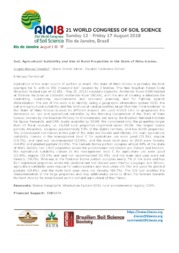Soil, agricultural suitability and use at rural properties in the state of Mato Grosso.
Soil, agricultural suitability and use at rural properties in the state of Mato Grosso.
Author(s): MENDES, A. M.; VILELA, G. F.; OSHIRO, O. T.
Summary: Agriculture is the main source of welfare in Brazil. The state of Mato Grosso is probably the best example for it, with its 903 thousand km2 covered by 3 biomes. The New Brazilian Forest Code (Brazilian Federal Law nº 12.651 - May 25, 2012) created a Cadastro Ambiental Rural (CAR) hosted at Sistema Nacional de Cadastro Ambiental Rural (SICAR), with the aim of creating a database for controlling, monitoring, environmental and economic planning, and for fighting against deforestation. The aim of this work is to identify, using a geographic information system (GIS), the soil and agricultural suitability and the land use at rural properties larger than ten 'rural modules' in the State of Mato Grosso accross its different biomes. We used ArcGIS 10.5 to geoprocess the databases on: soil and agricultural suitability by the Planning Department of the State of Mato Grosso; biomes by the Brazilian Ministry for Environment; soil use by the Brazilian National Institute for Space Research; and CAR, made available by SICAR. We considered only the properties larger than 10 fiscal modules, i.e. 16,669 rural properties registered under SICAR. The largest biome portion, Amazônia, occupies approximately 53% of the state's territory, and has 8,065 properties. The predominant soil classes in this part of the state are Oxisols and Ultisols, the main agricultural suitability classes in the management level C for agriculture use were good (23.3%), regular (39.7%), and land not recommended (20.6%), and the main land uses in 2014 were forestry (44.8%) and planted pasture (22.6%). The Cerrado biome portion occupies almost 40% of the state of Mato Grosso, has 7,910 properties where the predominant soil classes are Oxisols and Entisols, the agricultural suitability classes in the management level C for agriculture use were good (21.6%), regular (25.5%) and land not recommended (51.5%), and the main land uses were not forestry (78.2%). Whereas at the Pantanal biome portion occupies nearly 7% of the state and has 817 registered properties where the predominant soil classes were Plinthic subgoups and Alfisols, agricultura suitability were regular for native pasture and silviculture (43.3%) and good for planted pasture (19.6%), and the main land uses were not forestry (86.7%). The GIS tool enables the characterization of the large properties and may dditionally serve to direct the farmers towards the best choices for areas based on the soil and agricultural of their farms.
Publication year: 2018
Types of publication: Abstract in annals or event proceedings
Unit: Embrapa Territorial
Observation
Some of Embrapa's publications are published as ePub files. To read them, use or download one of the following free software options to your computer or mobile device. Android: Google Play Books; IOS: iBooks; Windows and Linux: Calibre.
Access other publications
Access the Agricultural Research Database (BDPA) to consult Embrapa's full library collection and records.
Visit Embrapa Bookstore to purchase books and other publications sold by Embrapa.

